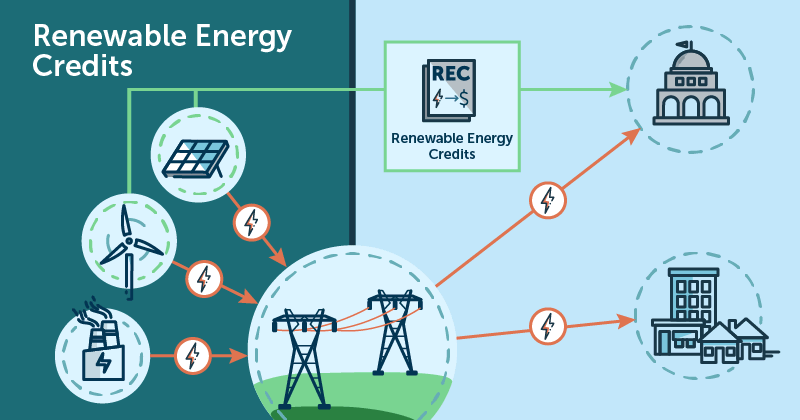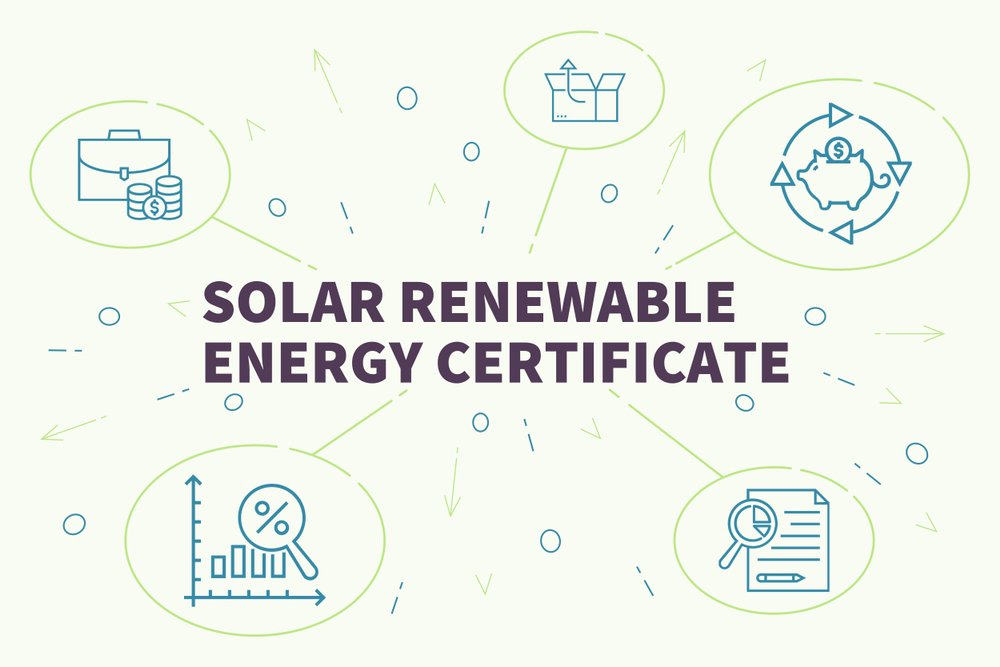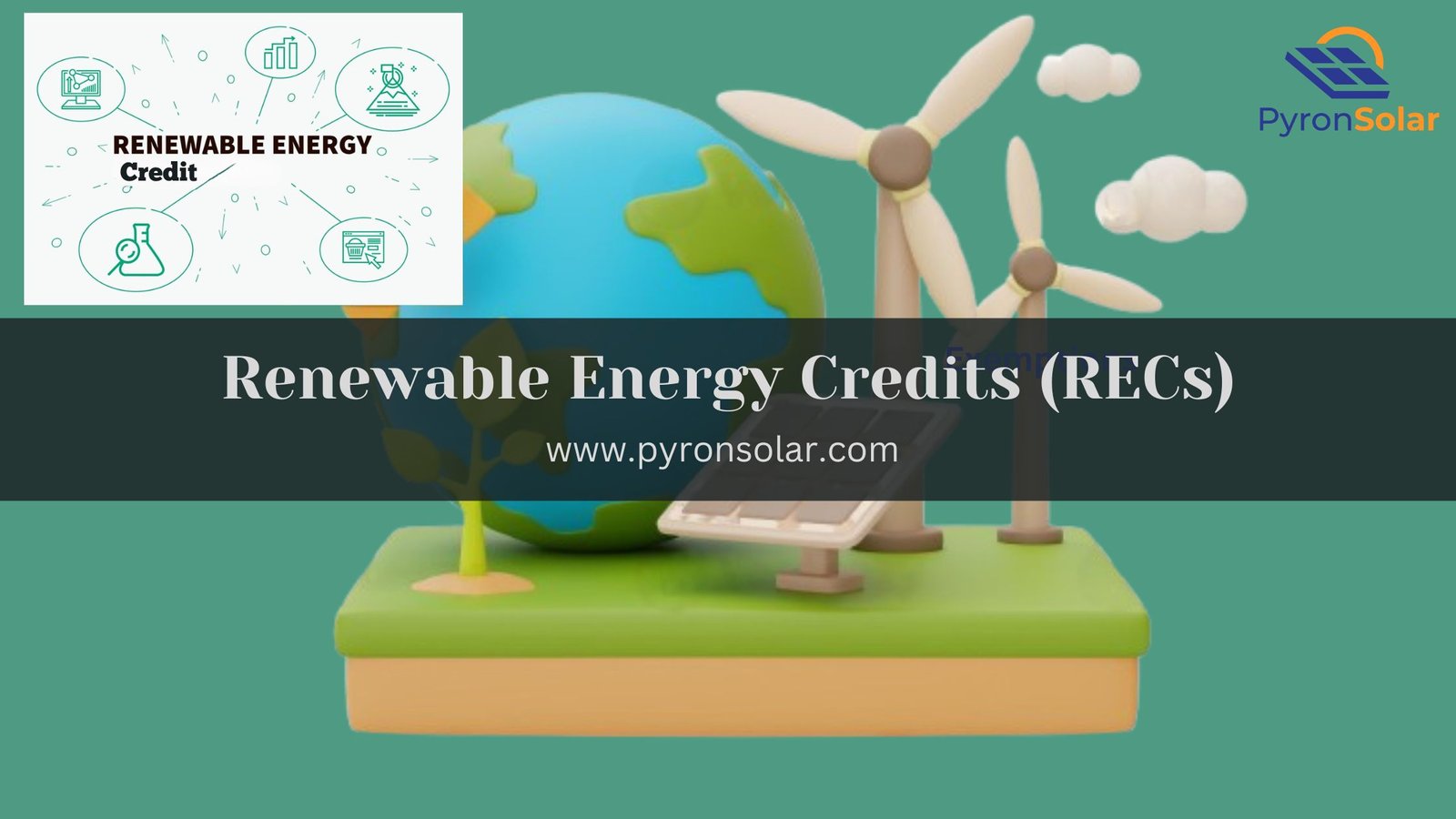Renewable energy credits (RECs) also known as renewable energy certificates, are defined as a market-based tool that is a certification of 1 MWh of power generated to the electricity grid from environmentally friendly and renewable sources such as solar energy or wind energy.
The main purpose of this green energy credits scheme is to encourage the investment and development of works related to solar and other types of renewable energy sources, meet regulatory requirements, and reduce carbon footprint. Moreover, solar project developers benefit from additional revenue by selling various types of RECs at different price ranges, which helps the companies in a smooth transition from fossil fuels to overcome the criticism and challenges faced against inconsistent climate change.
Let’s find out how to sell, track, and verify RECs and who can buy them by knowing how they differ from SRECs.
How Do Renewable Energy Credits Work?

Image Source: https://secondnature.org/
Renewable energy credits are generated per megawatt (MWh) of electricity produced by the physical source of energy and delivered to the grid. For example, if a wind farm produces 10 MWh of electricity, then 10 RECs will be generated.
These are the details included in each REC:
- Renewable Fuel Type
- Facility Location and Generation Date
- Certificate Data and Type
- Tracking System ID
- Project Description
- Project name and manufacturing date
- Certification of power generation
- Unique Identification Number Certificate
- Project interconnected to the utility
- Qualification for accreditation or renewable portfolio standard (RPS)
- Emission Rate of the Renewable Energy Source
RECs are tracked and recorded by highly skilled government and business-related companies. There is a unique ID assigned to each REC which includes the information related to source, generation date, and several others. Each region in the US has different tracking systems. For example, in New York, the RECs are assigned and tracked by the New York Generation Attribute Tracking System (NYGATS), which is a system operated by the state’s Energy Research and Development Department.
Companies use REC along with other forms of energy-related certifications such as zero-emission credits (ZECs) to support sustainability claims linked with the efforts to protect against climate change and fully comply with the regulations that focus on offsetting carbon emissions. REC represents the electricity that could have been generated from non-renewable sources such as coal, oil, and natural gas. But, they don’t guarantee a company’s energy consumption is completely renewable, nor do they similarly create emissions savings as carbon offsets for greenhouse gas emissions.
Types of Renewable Energy Credits(RECs)
These are main types of RECs listed below:
1. Small Scale Technology Certificates are suitable for installing solar water heaters, air source heat pumps, and small-scale generation units such as solar panels, wind, and hydroelectricity systems.
2. Large Scale Technology Certificates include renewable energy projects such as hydroelectric programs, and solar and wind energy farms that are authorized to create large scale generation certificates (LGCs).
3. Voluntary REC Markets are purchased by individuals or environmentally friendly organizations aiming to support renewable energy and reduce carbon footprint. Due to its lower demand, states that have voluntary markets have reduced REC prices.
4. Compliance REC Markets are applicable in states with renewable portfolio standards (RPS) that are highly expensive and set by the governments. Utilities are required to generate certain power from renewable sources, and falling short, it becomes mandatory to purchase RECs to increase the demand and prices in these states.
5. Bundled RECs are sold together with linked with renewable energy that comes with new build projects for developers to gain financing and develop the project.
6. Unbundled RECs are sold separately and aren’t linked to their source of power. Although companies can purchase these types of RECs to attain sustainable targets, they don’t have a positive impact on the environment. This is because they don’t contribute to new renewable energy being produced and cause rearrangement of existing renewable energy production on the current market.
What are the Benefits of Renewable Energy Credits(RECs)?
These are the important benefits of buying RECs:
- Emission Reductions: RECs help reduce your dependence on fossil fuels, thereby minimizing the carbon footprint and contributing to less pollution and climate change.
- Additional Income: Renewable energy producers find RECs as an extra source of income. This is because the companies buying RECs provide support to renewable energy projects financially, thereby making the system much more cost-effective and producing huge green energy.
- Proof of Renewable Energy Use: RECs are documented proof to customers to indicate that the power is used from renewable energy providers. As a result, customers benefit from the possibility of using different amounts of renewable energy in various locations without having the requirement to invest in facilities and components to generate power themselves.
- Increase Demand for Renewable Energy: It is possible to increase the production of renewable energy by purchasing more RECs to send a demand signal to the market. The increased demand for RECs results in the development of more renewable energy projects to fulfill the demand and reduce the dependence on fossil fuels to promote a clean and sustainable energy grid.
What are the Challenges and Criticisms of Renewable Energy Credits(RECs)?
These are the main threats and negative sides of RECs you need to know:
1. Market Fluctuations: Mainly, the REC value fluctuates due to frequent changes in supply and demand patterns, changes in energy policies, and geographical differences, which makes it difficult for renewable energy project owners to estimate a consistent income source. This results in reducing the long-term investment in renewable energy projects and slowing down market growth.
2. Less Transparency: A lack of transparency in REC pricing reduces long-term investment in renewable energy projects and slows down market growth. Also, the lack of a rigorous verification process allows for more fraud and misleading information, which is a threat to the market’s trustworthiness.
How To Sell Renewable Energy Credits(RECs)?
These are the main steps you should follow while selling RECs:
1. Understand the basics of RECs: Familiarize yourself with the basic concepts of RECs so that you can sell the RECs separately from the physical electricity.
2. Certify your RECs: Before selling RECs, the first step you should follow is to find a reliable source to generate renewable energy which includes solar, wind, biomass, geothermal, and hydropower. You should check that the energy produced must satisfy the certification standards and is regulated by the appropriate governing authority.
3. Register with Tracking Systems: It is important to register and verify your RECs with appropriate local or national tracking systems.
4. Prepare and Validate RECs: Once you have completed the registration process for electricity generation, the tracking systems assign you one REC for each megawatt-hour (MWh) of electricity produced, which symbolizes the positive aspects of non-toxic energy.
5. Search for a Genuine Buyer: You should search for a trustworthy buyer, which includes utilities and companies interested in buying RECs to decrease their carbon footprint.
6. Bargain the Deal: Considering the critical factors for REC sale including the cost, contract tenure, and other related information, it is essential to negotiate the deal according to the market demand, renewable energy type, and your region’s laws.
7. RECs Transfer: Once you and your buyer have accepted the terms and conditions mentioned in the agreement, use the tracking system platform to transfer RECs to fulfill the demand of renewable energy goals or legal needs.
8. Payment and Paperwork: You will receive funds for the RECs sold based on the accepted terms, once the transfer is successful. Also, ensure to save proper transaction records.
9. Compliance with Documentation Requirements: You need to keep up with the documentation requirements on the renewable energy generated, and REC sales based on your location.
How to Track and Verify Renewable Energy Credits(RECs)?
RECs are tracked and verified using these two main approaches in the U.S. explained below in detail:
1. Certificate-based tracking systems are maintained by only one organization. The basic information about each MWh of renewable energy generated in a particular region in the U.S. is maintained in the electronic databases.
Similar to the method of transferring currency through the online banking system, you can transfer REC among account holders using the electronic tracking system, assigning a unique identification number to each REC. This ensures that a single REC is given per MWh of energy generation to avoid issues such as double issuance of credits. Also, a REC is unique and can be owned by one account holder at a time.
2. The contract path tracking method is one of the traditional methods in the industry that tracks REC ownership from the source to the consumer. This approach includes third-party reports complemented with several other proofs of generation such as declarations, certified statements, and contract receipts. These are the documents that prove the transfer of ownership between the generator, mediator, and final seller to the end consumer. Most often, metered recordings of data are used to back up and validate certifications and supply contracts. The auditing services fees in the U.S. vary according to different regions.
Usually, the costs of tracking the contracts are handled by the third party or intermediate supplier or the end consumer who handles the contract.
Finally, the end consumers who purchase the third-party certification and verification of green power products are guaranteed that their purchase is unique and can fulfill the nation’s accepted standards for manufacturing, since it is supported by renewable energy supply contracts.
How Are Renewable Energy Credits(RECs) Priced?
These are the factors influencing the renewable energy credit (REC) prices in the market that vary according to each state in the U.S.:
1. Market Type: The states are categorized into these two main REC market types which include voluntary markets and compliance markets as discussed above in detail.
2. Geographical Location: RECs varies state-to-state. For example, in Ohio, 1 REC was priced below $35 in 2011 and within four years, the value dropped to $8 in 2015. Comparing the cost in New England in the same period, it was less than $20 in 2011 and the price range increased between $45–$50 in 2015.
3. REC Selling Methods: it includes two methods — bundled RECs and unbundled RECs.
4. Supply and Demand: Oversupplying REC indicates its low demand with a reduced price, while a high demand points out the increase in prices.
5. Technology: REC buyers have their preferences for certain technology types for various reasons, which include business development and product value, thereby having an impact on its pricing.
What are Solar Renewable Energy Credits (SRECs)?

Solar energy renewable credits (SRECs) are the certificates or performance-based incentives that allow homeowners and companies to earn extra income from their solar energy systems for generating every 1 megawatt-hour (MWh) or 1,000 kWh of power.
These are the benefits of SRECs:
- Pricing: The fixed pricing allows you to estimate how much you will earn by selling SREC in advance. This helps you manage extra income and budget for additional financial requirements.
- Clearing the solar loans: By pre-selling the SREC rights, it becomes easier to use the money and clear the solar loans you took to purchase the system. Few companies provide huge sums of money to pay off your loans or offer deals where the income from your SRECs is used to clear your monthly loan payments.
- Satisfaction to users: You will gain numerous benefits and satisfaction from pre-selling SRECs or selling your SRECs for a predetermined price. Mainly, you will get peace of mind against the unstable prices that allow you to sell SRECs on the spot.
You can find SRECs in these states in the U.S. such as Pennsylvania, Maryland, D.C. (District of Columbia), Delaware, Massachusetts, Illinois, Virginia, New Jersey, and Ohio.
Who Should Buy Renewable Energy Credits?
Two important types of REC buyers can purchase Renewable Energy Credits, such as Voluntary purchasers and Compliance purchasers.
Voluntary credit buyers are organizations that are environmentally conscious and focus on minimizing greenhouse gas emissions. These companies have several reasons for buying RECs and have a set of renewable energy goals as they are searching for a company to know where electricity is generated. Also, homeowners come under this category to provide individual support towards renewable energy.
Compliance credit buyers are the electrical service providers that are contractually bound to maintain a specified percentage of electricity produced from renewable sources. Few states with RPS regulations have requirements for energy use, and the law states that the utility must provide renewable credits as evidence that it generates electricity from renewable sources. Overall, the utility can build RECs using renewable energy or purchase them if they aren’t able to produce in sufficient amounts.
Ray is an avid reader and writer with over 25 years of experience serving various domestic and multinational private and public energy companies in the USA.

